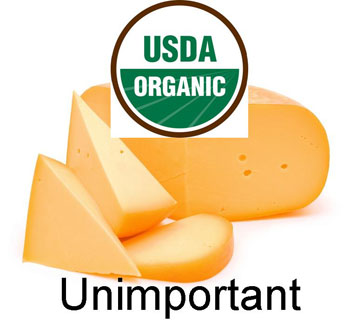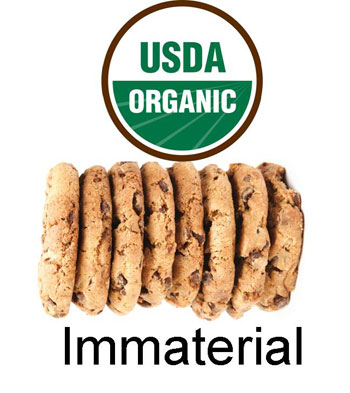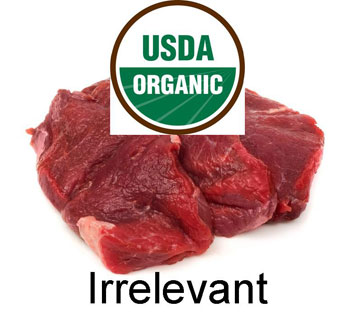|
 The
Organic Food Movement—Too Little, Too Late The
Organic Food Movement—Too Little, Too Late
At the
McDougall Program we do not actively teach people to buy
organic foods because the immediate health benefits would be
imperceptible and the harm to the health of a few
participants from this extra requirement would be
substantial. Yet, in the McDougall home, we make every
effort to buy organic foods for ourselves. And, if you ask
me directly, I will tell you to shop for organic foods.
Does this seem like double talk?
My
patients are overweight and sick because they have learned
to eat, from childhood, the richest diet known to
humankind—a diet of animals, oils, and sugars. Dining for a
lifetime on “organically farmed” meat, poultry, fish,
cheese, milk, honey, and flour would have caused them the
exact same states of poor health. Along the same lines of
thought, switching my patients to conventionally grown
potatoes, rice, corn, vegetables, and fruits results in
profound improvements in their health in 10-days—organic
varieties of these plant foods would have not made a speck
of difference.

Dietary
change is difficult. Immediate improvements, such as relief
of chest pain, indigestion, headaches, arthritis,
constipation, oily skin, along with reductions in
cholesterol, triglycerides, blood pressure, body weight, and
the need for medications are some of the benefits that
follow this change and encourage future compliance.
Insisting on organically grown, instead of conventionally
grown, fruits and vegetables would place an additional
obstacle before patients increasing their chances of
failure—and in so doing harm their health. Fortunately, the
decisions to eat organic and the McDougall Diet are not
mutually exclusive—you can, and should, do both.
What’s
Organic?
The term
“organically grown food” refers to products produced in
accordance with the principles and practices of organic
agriculture. Various countries legally regulate organic
food. In the US, Canada, Japan, and the European Union,
producers must obtain certification in order to label their
products “organic.” Traditionally, organic farming has been
tied to small farms, but since the early 1990s, with a
growth rate of 20% a year, organic food production has
become the business of large companies, such as Kraft,
Pepsi, General Mills, Kellogg, Conagra, Coca-Cola, M&M Mars,
and Hershey, to name a few well recognized giants in the
industry. Currently, organic food accounts for only 1 to 2%
of food sales worldwide.
Many
people perceive organic as an unwise purchase. Because of
intensive labor practices, such as crop rotations, natural
pest control, and the use of manures, most organic foods
cost more. Organic fruits and vegetables are not treated
with waxes and preservatives, which results in earlier
spoilage. They can be odd shaped, discolored, and smaller.
In most cases, however, organic foods look identical to
their conventional counterparts. Tests show consumers find
no taste difference between organically grown and
conventional foods.
|
Goals of organic farming include:
Increase long-term fertility of
soils
Minimize all forms of pollution
Avoid the use of synthetic
fertilizers and pesticides
Maintain genetic diversity
Produce high quality food
Use local resources rather than
importing long distance
Keep use of fossil fuels to a
minimum. |
Single
foods, such as bananas, asparagus, or lettuce are designated
as “organic” based on compliance to designated farming
practices. In the US, foods that have several ingredients,
such as breakfast cereal, can use the USDA organic seal or
the following wording on their package labels:
100
percent organic: Products are completely organic or
made of all organic ingredients.
Organic: Products that are at least 95 percent
organic.
Made with organic ingredients: Products contain at
least 70 percent organic ingredients.
The
organic certification label is not a guarantee that the
product complies with the organic standards. Inspection of
farming practices is spotty and can be especially
problematic for items produced in poorly regulated
countries.
Organic
Does Not Mean Healthy
You would
think better soil nutrient recycling (composting), crop
rotation to avoid soil mineral depletion, and encouragement
of the soil microorganisms that improve nutrient uptake
would result in nutritionally superior food on your dinner
plate. The truth is there is no conclusive evidence that
shows that organic fruits and vegetables are more nutritious
than are conventionally grown ones.1 Furthermore,
“organic” certification does not claim that these products
are safer except for the pesticide issue discussed below.2
Real harm
to the public is caused when the organic label is placed on
inherently unhealthy products. Production of meat and dairy
products by organic standards is as meaningful as the
production of tobacco for cigarettes and rye for whiskey by
organic standards. How does that saying go? “Putting
lipstick on a sow’s ear won’t turn it into a silk purse.”
Advertising campaigns are misleading people into believing
burgers, chips, cakes and biscuits that are marked “organic”
are good for us.

Organic
Food Is Cleaner
The use of
fossil-fuel-derived pesticides and fertilizers began near
the end of World War II. Currently, nearly all of the 450
pesticides that are allowed in conventional farming are
prohibited in organic farming, and the seven that are
allowed are not used routinely. These prohibited chemicals
are involved in the cause of four emotionally-charged health
issues: birth defects, infertility, brain damage
(Parkinson's Disease) and cancers of children (neuroblastoma,
leukemia, etc.) and adults (breast, pancreatic, etc.).
Children fed a diet of organic foods are exposed to six to
nine times fewer toxic pesticides than are children fed a
conventional diet.3
Getting
back to the theme of this newsletter, buying organic is not
the most effective way to reduce your intake of potentially
dangerous environmental chemicals. Switching from
animal-food to plant-food is the most effective. Estimates
are 89% to 99% of the chemical intake into our body is from
our food, and most of this is from foods high on the food
chain: meat, poultry, fish, and dairy products.4-6
In his Pulitzer Prize nominated book, How to Survive in
America the Poisoned, Lewis Regenstein writes: “Meat
contains approximately 14 times more pesticides than do
plant foods...Thus, by eating foods of animal origin, one
ingests greatly concentrated amounts of hazardous
chemicals.” The reason for these high levels of
contamination is because most pesticides and herbicides are
attracted to and stored in fat. Low levels found on the
grasses and grains that are fed to the chicken, pigs and
cattle accumulate in their body fat in very high
concentrations for people to eat.
Until the
end of the Second World War, farmers produced bountiful
harvests without relying on pesticides and other toxic
chemicals. There is no reason why the world cannot do so
again. Most people who have ever walked this earth have
followed primarily plant-food (starch)-based diets. We can
do that again too.
|
Buyer’s Tips7
These foods traditionally have
the highest pesticide residue: Apples, Peaches,
Bell peppers, Pears, Celery, Potatoes, Cherries,
Raspberries, Imported grapes, Spinach,
Nectarines, and Strawberries. Spending extra
for organic varieties of these is wise.
These foods traditionally have
the lowest pesticide residue: Asparagus, Kiwis,
Avocados, Mangoes, Bananas, Onions, Broccoli,
Papayas, Cauliflower, Pineapples, Sweet corn,
and Sweet peas. Buying conventionally grown
seems relatively safe.
Other important steps to remove
chemicals would be to wash and scrub produce
under streaming water (do not use soap), peel
fruits and vegetables, and remove the outer
leaves of leafy vegetables. |
Eating
Organic to Save Fossil Fuels
The
harnessing of fossil fuels allowed for the world's
population explosion from 1 billion people at the middle of
the 19th century to 6.3 billion at the turn of
the 21st century. At the same time fossil fuel
dependency has led us to the verge of planetary destruction.
One of the primary goals of the organic movement is to save
the Earth. Organic farming of plant-foods for people will
minimize environmental damage by abandoning the use of
oil-derived pesticides and fertilizers. These chemicals, for
example, account for half of the energy input in
conventional potato and winter wheat production and up to 80
per cent of the energy consumed in some vegetable crops.8
The food
supply in the United States requires the use of about 530
liters of “oil equivalents” per person annually, just for
the agricultural sector.9 However, this is just a
fraction of the total fossil energy expended—processing,
packaging, and distribution increase the commercial energy
consumption by more than 3 times. Organic products that are
transported long distances, particularly by airplane, are as
environmentally damaging as conventional foods. Buying
plant foods locally, especially from Farmer’s Markets, can
be very environmentally and pocketbook friendly.
Abandoning
the meat and dairy foods—organically or conventionally
raised—would result in the largest savings in fossil fuels.
Consider just for their growing needs, the average energy
input from fossil fuels is 25 Calories in order to produce 1
Calorie of animal protein. This is more than 11 times
greater than the 2.2 Calories of fossil energy that are
required for 1 Calorie of grain protein production.10

“Organic” Meat and Milk Are Still Meat and Milk
“Organic
farming” and “environmentally friendly” will remain
contradictions until the movement abandons “organic”
livestock production. According to a report, Livestock’s
Long Shadow –Environmental Issues and Options, released in
November of 2006 from the United Nations Food and
Agriculture Organization, livestock emerges as one of the
top two or three most significant contributors to every one
of the most serious environmental problems.
Livestock
(beef cattle, dairy cattle, chickens, pigs, and a few other
animals domesticated for food uses) produced by even the
highest organic standards will still generate, from their
belching, flatus, and manure, 18% of the world’s greenhouse
gasses. The same 26 percent of the ice-free terrestrial
surface of the planet will be required for grazing and the
same 33 percent of the total arable land of our planet will
still be dedicated to producing feed crops for these
“organic” animals. Nothing saved here by going organic.
We Can
Fix Our Food Supply
Environmental threats combined with energy scarcity are
already causing food shortages and increasing prices—and
there is every reason to expect rapid escalation of these
problems. I believe we have enough time, knowledge, money,
energy, and political power to make massive transformations
in our food systems. Switching to organic practices of plant
food production is important for long-term sustainability.
However, the one crucial step that must be taken now is the
universal adoption of the same principles I teach
individuals to save their lives at the McDougall Program:
changing to a starch-based diet. On average, land
requirements for meat-protein production are 10 times
greater than for plant-protein production. About 40% of the
world’s grain harvest is fed to animals. Half of this amount
of grain would be more than enough to feed all the people on
our planet.11 Almost overnight, the principles of
the McDougall Diet will feed 7 billion inhabitants for the
next generation and beyond. You may laugh, but this change
will not be a matter of choice.
References:
1)
Magkos F, Arvaniti F, Zampelas A. Organic food: nutritious
food or food for thought? A review of the evidence. Int J
Food Sci Nutr. 2003 Sep;54(5):357-71.
2)
Magkos F, Arvaniti F, Zampelas A. Organic food: buying more
safety or just peace of mind? A critical review of the
literature. Crit Rev Food Sci Nutr. 2006;46(1):23-56.
3) Curl
CL, Fenske RA, Elgethun K. Organophosphorus pesticide
exposure of urban and suburban preschool children with
organic and conventional diets. Environ Health Perspect.
2003 Mar;111(3):377-82
4)
Duarte-Davidson R. Polychlorinated biphenyls (PCBs) in the
UK population: estimated intake, exposure and body burden.
Sci Total Environ. 1994 Jul 11;151(2):131-52.
5) Liem
AK. Exposure of populations to dioxins and related
compounds. Food Addit Contam. 2000 Apr;17(4):241-59.
6) Rivas A, Cerrillo I,
Granada A, Mariscal-Arcas M, Olea-Serrano F. Pesticide
exposure of two age groups of women and its relationship
with their diet. Sci Total Environ. 2007 Aug
15;382(1):14-21.
7)
http://www.foodnews.org/
8)
http://www.energybulletin.net/node/5045
9) Food, Land, Population and
the U.S. Economy, Pimentel, David and
Giampietro, Mario. Carrying Capacity Network, 11/21/1994.
http://dieoff.org/page55.htm
10)
Pimentel D, Pimentel M. Sustainability of meat-based and
plant-based diets and the environment. Am J Clin Nutr.
2003 Sep;78(3 Suppl):660S-663S
11)
Leitzmann C. Nutrition ecology: the contribution of
vegetarian diets. Am J Clin Nutr. 2003 Sep;78(3 Suppl):657S-659S). |